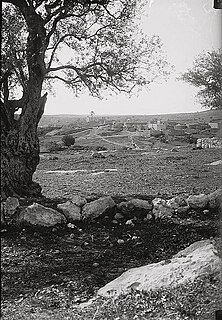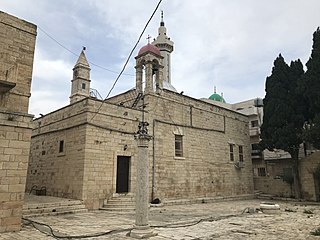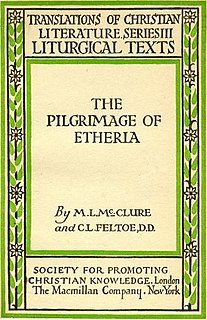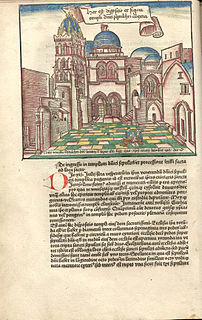
The Monastery of the Cross is an Eastern Orthodox monastery near the Nayot neighborhood of Jerusalem. It is located in the Valley of the Cross, below the Israel Museum and the Knesset.

Church of the Sepulchre of Saint Mary, also Tomb of the Virgin Mary, is a Christian tomb in the Kidron Valley – at the foot of Mount of Olives, in Jerusalem – believed by Eastern Christians to be the burial place of Mary, the mother of Jesus. The Status Quo, a 250-year old understanding between religious communities, applies to the site.

Felix Fabri was a Swiss Dominican theologian. He left vivid and detailed descriptions of his pilgrimages to Palestine and also in 1489 authored a book on the history of Swabia, entitled Historia Suevorum.
Shams al-Dīn Abū ʿAbd Allāh Muḥammad ibn Aḥmad ibn Abī Bakr al-Maqdisī, better known as al-Maqdisī or al-Muqaddasī, was a medieval Arab geographer, author of Aḥsan al-taqāsīm fī maʿrifat al-aqālīm, as well as author of the book, Description of Syria . He is one of the earliest known historical figures to self-identify as a Palestinian during his travels.

The Itinerarium Burdigalense, also known as the Itinerarium Hierosolymitanum, is the oldest known Christian itinerarium. It was written by the "Pilgrim of Bordeaux", an anonymous pilgrim from the city of Burdigala in the Roman province of Gallia Aquitania.

Willibald was an 8th-century bishop of Eichstätt in Bavaria.

Az-Zakariyya or Zakaria was a Palestinian Arab village 25 km northwest of the city Hebron (al-Khalil) in the Hebron Subdistrict, and about 12 kilometres (7.5 mi) north-northwest of Bayt Jibrin, which was depopulated after the end of the 1948 Arab–Israeli War. The village had a population of 1,180 on 15,320 dunums in 1945. The village was named in honor of the prophet Zachariah.

Bethany or what is locally known as Al-Eizariya or al-Azariya, is a town in the West Bank. The name al-Eizariya refers to the New Testament figure Lazarus of Bethany, who according to the Gospel of John, was raised from the dead by Jesus. The traditional site of the miracle, the Tomb of Lazarus, in the city is a place of pilgrimage.

The Church of the Visitation is a Catholic church in Ein Karem, Jerusalem, and honors the visit paid by the Virgin Mary, the mother of Jesus, to Elizabeth, the mother of John the Baptist. This is the site where tradition tells us that Mary recited her song of praise, the Magnificat, one of the most ancient Marian hymns.

The Saint George's Monastery in Al-Khader or Church of Saint George is an Eastern Orthodox Christian monastery in the Palestinian town of al-Khader, near Beit Jala and Bethlehem in the central West Bank. The town of Al-Khader is named after Saint George, who in Arab culture is known as "al-Khadr."
The anonymous pilgrim of Piacenza, sometimes simply called the Piacenza Pilgrim, was a sixth-century Christian pilgrim from Piacenza in northern Italy who travelled to the Holy Land at the height of Byzantine rule in the 570s and wrote a narrative of his pilgrimage. This anonymous pilgrim was erroneously identified as Antoninus of Piacenza or Antoninus Martyr out of confusion with Saint Antoninus of Piacenza, who died in 303 and is venerated as a martyr.
Daniel the Traveller, known also as Daniel the Pilgrim, Daniel of Kiev, or Abbot Daniel, was the first travel writer from the Kievan Rus. Some have identified him with a certain Daniel, bishop of Yuryev between 1115 and 1122.

The Church of Saint Anne is a French Roman Catholic church and French national domain located at before start of the Via Dolorosa, between the Lions' Gate and of the Second Station of the Cross, in the Muslim Quarter of the Old City of Jerusalem.

Mar Elias Monastery is a Greek Orthodox monastery in south Jerusalem, on a hill overlooking Bethlehem and Herodium.

Hebron Glass refers to glass produced in Hebron as part of a flourishing art industry established in the city during Roman rule in Palestine. The Old City of Hebron still contains a quarter named the "Glass-Blower Quarter" and Hebron glass continues to serve as a tourist attraction for the city.

The Church of Saint John the Baptist is a Catholic church in Ein Kerem, Jerusalem, that belongs to the Franciscan order. It was built at the site where Saint John the Baptist was believed to have been born.

Travelogues of Palestine are the written descriptions of the region of Palestine by travellers, particularly prior to the 20th century. The works are important sources in the study of the history of Palestine and of Israel. Surveys of the geographical literature on Palestine were published by Edward Robinson in 1841, Titus Tobler in 1867 and subsequently by Reinhold Röhricht in 1890. Röhricht catalogued 177 works between 333—1300CE, 19 works in the 14th c., 279 works in the 15th c., 333 works in the 16th c., 390 works in the 17th c. 318 works in the 18th c., and 1,915 works in the 19th c.

Bernhard von Breidenbach was a politician in the Electorate of Mainz. He wrote a travel report, Peregrinatio in terram sanctam (1486), from his travels to the Holy Land.

The Inn of the Good Samaritan is a national park, museum, ancient archaeological site and former inn administered by the Israel Nature and Parks Authority located near Ma'ale Adumim, halfway between Jerusalem and Jericho, at an elevation of 298 meters above sea level.
Historical sources of the Crusades: pilgrimages and exploration include those authors whose work describes pilgrimages to the Holy Land and other explorations to the Middle East and Asia that are relevant to Crusader history. In his seminal article in the Catholic Encyclopedia, Dominican friar and historian Bede Jarrett (1881–1934) wrote on the subject of Pilgrimage and identified that the "Crusades also naturally arose out of the idea of pilgrimages." This was reinforced by the Reverend Florentine Stanislaus Bechtel in his article Itineraria in the same encyclopedia. Pilgrims, missionaries, and other travelers to the Holy Land have documented their experiences through accounts of travel and even guides of sites to visit. Many of these have been recognized by historians, for example, the travels of ibn Jubayr and Marco Polo. Some of the more important travel accounts are listed here. Many of these are also of relevance to the study of historical geography and some can be found in the publications of the Palestine Pilgrims' Text Society (PPTS) and Corpus Scriptorum Eccesiasticorum Latinorum (CSEL), particularly CSEL 39, Itinerarium Hierosolymitana. Much of this information is from the seminal work of 19th-century scholars including Edward Robinson, Titus Tobler and Reinhold Röhricht. Recently, the Independent Crusaders Project has been initiated by the Fordham University Center for Medieval Studies providing a database of Crusaders who traveled to the Holy Land independent of military expeditions.
















